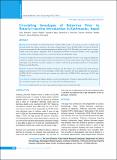Please use this identifier to cite or link to this item:
https://hdl.handle.net/20.500.14356/1146| Title: | Circulating Genotypes of Rotavirus Prior to Rotarix?vaccine Introduction in Kathmandu, Nepal |
| Authors: | Shrestha, Sony Thakali, Ocean Raya, Sunayana Sherchan, Samendra Shrestha, Laxman Parajuli, Keshab Sherchand, Jeevan Bahadhur |
| Citation: | ShresthaS., ThakaliO., RayaS., SherchanS., ShresthaL., ParajuliK., & SherchandJ. B. (2021). Circulating Genotypes of Rotavirus Prior to Rotarix?vaccine Introduction in Kathmandu, Nepal. Journal of Nepal Health Research Council, 19(03), 508-512. https://doi.org/10.33314/jnhrc.v19i3.3512 |
| Issue Date: | 2021 |
| Publisher: | Nepal Health Research Council |
| Article Type: | Original Article |
| Keywords: | Children under five years of age diarrhea Nepal rotavirus strains RT_PCR |
| Series/Report no.: | July-Sep, 2021;3512 |
| Abstract: | Abstract Background: In Nepal, it is estimated that about 3 million children under 5 years of age are prone to diarrhea and previous studies have shown rotavirus as the major etiological agent. Given the high burden of rotavirus, Rotarix® vaccine was introduced in the national immunization schedule in July 2020. This study was carried out in a tertiary health center from January- September 2018 to determine the burden of rotavirus diarrhea as well as genotypic variations in the circulating virus prior to vaccine introduction in Kathmandu, Nepal. Methods: Hospital based cross sectional study was conducted among children less than 5 years of age attending Kanti Children’s Hospital. Rotavirus antigen detection was performed by enzyme immunoassay using ProSpecT Rotavirus Microplate Assay. Rotavirus A positive samples were further confirmed by genotyping using Reverse-Transcription Polymerase Chain Reaction. Results: A total of 530 children that included 184 males and 346 females were enrolled in this study. Rotavirus antigen was detected in 112 (21.1%) stool samples. Of the total 112 positive EIA stool samples that were genotyped, G12P[6] (30.3%) was found to be the most common type, followed by G3P[8] (26.8%), mixed type (14.3%), and G1P[6] (13.4%). Conclusions: Continued surveillance should be carried out nationwide in Nepal to understand the effectiveness of the vaccination program and to report any new trends in the circulating genotypes. Keywords: Children under five years of age; diarrhea; Nepal; rotavirus strains; RT_PCR |
| Description: | Original Article |
| URI: | http://103.69.126.140:8080/handle/20.500.14356/1146 |
| ISSN: | Print ISSN: 1727-5482; Online ISSN: 1999-6217 |
| Appears in Collections: | Vol. 19 No. 03 (2021): Vol 19 No 3 Issue 52 Jul-Sep 2021 |
Files in This Item:
| File | Description | Size | Format | |
|---|---|---|---|---|
| 3512-Manuscript-25067-1-10-20211215.pdf | Fulltext Download | 233.59 kB | Adobe PDF |  View/Open |
Items in DSpace are protected by copyright, with all rights reserved, unless otherwise indicated.
